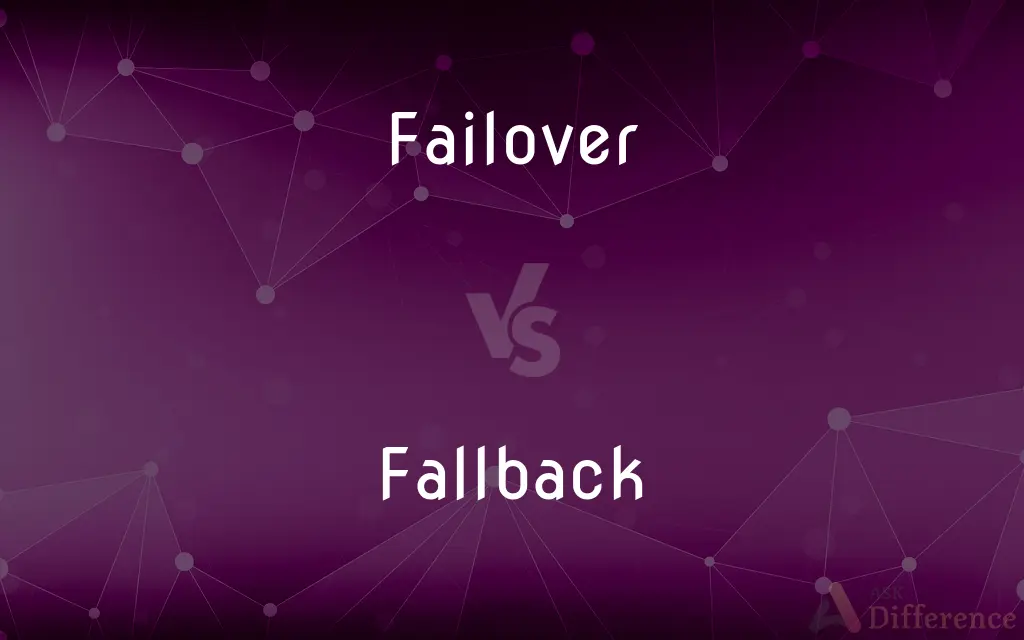Failover vs. Fallback — What's the Difference?
By Fiza Rafique & Maham Liaqat — Updated on March 9, 2024
Failover is a redundancy strategy for automatic switching to a backup system upon failure, while fallback refers to a manual or predefined switch back to a previous system or state when a new system fails or issues arise.

Difference Between Failover and Fallback
Table of Contents
ADVERTISEMENT
Key Differences
Failover is a proactive approach in IT and networking designed to ensure system reliability and availability. Fallback, on the other hand, is a reactive measure that comes into play when a new or secondary system encounters issues or when the primary system has been restored after a failure.
Failover systems are typically part of a high-availability strategy, where redundancy is built into the IT infrastructure to automatically compensate for any system failures. Fallback procedures may involve manual intervention to revert operations back to the original system or to another stable state.
Fallback strategies are designed to provide a safety net when transitioning between systems or after an attempted improvement fails. Failover is about prevention and immediate response to issues without disrupting the user experience.
While failover and fallback both aim to enhance system resilience and reliability, they do so at different stages of incident management. Failover addresses the immediate aftermath of a system failure, ensuring that services continue to run. Fallback, however, is concerned with recovery and stability, ensuring that operations can return to a normal or previously stable state after an unsuccessful transition or when the failover system itself is compromised.
Both failover and fallback are critical components of disaster recovery and business continuity planning. Implementing both strategies allows organizations to handle system failures more effectively, minimizing downtime and ensuring that critical functions remain operational under various scenarios.
ADVERTISEMENT
Comparison Chart
Purpose
To automatically switch to a backup system upon failure
To revert to a previous system/state when a new system fails
Automation
Highly automated, requiring no human intervention
May require manual intervention or be semi-automated
Scenario
Used during the initial failure of a primary system
Used after failover or when new systems fail to perform as expected
Focus
Maintaining continuity and minimizing downtime
Restoring original state or moving to a stable system
Implementation
Part of high-availability strategies for critical systems
Safety measure for ensuring stability after changes or failures
Compare with Definitions
Failover
Automatic transition to a redundant or standby system upon failure.
The data center's failover mechanism activated seamlessly during the outage.
Fallback
A manual or planned process to return to a previous system state.
We initiated a fallback to the older software version after the update issues.
Failover
A process ensuring continuous operation by switching to backup components.
Failover procedures are tested quarterly to ensure reliability.
Fallback
The action of falling back to a less advanced state.
Fallback to manual processing ensured business continuity during the system failure.
Failover
A redundancy strategy for critical systems.
Failover systems are essential for our 24/7 operational needs.
Fallback
A contingency plan for technology failures or security breaches.
Our fallback strategy includes manual checks and balances.
Failover
The act of failing over to a secondary system.
The failover occurred at midnight with no user impact.
Fallback
A risk mitigation and recovery strategy.
Fallback options are critical for managing unforeseen IT issues.
Failover
A feature in high-availability systems for minimizing downtime.
Our cloud service includes failover capabilities to maintain uptime.
Fallback
Reversion to a safer or more stable configuration.
Fallback plans are in place for emergency downgrades.
Failover
Failover is switching to a redundant or standby computer server, system, hardware component or network upon the failure or abnormal termination of the previously active application, server, system, hardware component, or network in a computer network. Failover and switchover are essentially the same operation, except that failover is automatic and usually operates without warning, while switchover requires human intervention.
Fallback
Something to which one can resort or retreat
Applied to another college as a fallback.
Failover
An automatic switch to a secondary system on failure of the primary system, such as a means for ensuring high availability of some critical resource (such as a computer system), involving a parallel backup system which is kept running at all times, so that, upon detected failure of the primary system, processing can be automatically shifted over to the backup.
Fallback
A retreat
The colonel ordered a fallback to the woods.
Fallback
Something that falls back
The fallback of debris from the explosion.
Fallback
An act of falling back.
A failure of one of the rocket's first-stage engines just after liftoff would result in a destructive pad fallback.
The black hole formed as a result of fallback of ejecta onto the neutron star initially created by the supernova explosion.
Fallback
A backup plan or contingency strategy; an alternative which can be used if something goes wrong with the main plan; a recourse.
As a fallback, I suppose we can use typewriters if the word processing system fails.
Fallback
(construction) A reduction in bitumen softening point, sometimes called refluxing or overheating, in a relatively closed container.
Fallback
Pulverised material that falls back to earth after a nuclear explosion; fallout.
Fallback
That can be resorted to as a fallback.
A fallback plan
Fallback
The act or process of falling back.
Fallback
Something or someone to which one resorts as an alternative to a failed resource or method.
Fallback
To break off a military action with an enemy
Common Curiosities
What is failover?
Failover is an automated process that allows a system to switch to a backup upon detecting a failure, ensuring service continuity.
Is failover immediate?
Yes, failover is designed to be immediate to minimize downtime and ensure seamless service continuity.
What is a fallback?
Fallback is the process of reverting to a previous or original system or state, typically after a new system fails or when failover needs to be reversed.
When would a fallback be used?
Fallback is used when a new or secondary system doesn’t perform as expected, or the original system is restored and deemed more stable.
Can fallback procedures be automated?
While some fallback procedures can be semi-automated, they often require manual checks or intervention to ensure the stability of the reverted system.
Why are failover systems important?
They are crucial for maintaining the availability of critical services, especially in industries where downtime can lead to significant losses or risks.
How do organizations test failover systems?
Organizations conduct regular drills and simulations to ensure failover systems work effectively and can handle real-world scenarios.
Can failover be used for non-critical applications?
While possible, the cost and complexity of implementing failover for non-critical applications may not always be justified.
What role does fallback play in business continuity?
Fallback procedures are a key part of ensuring that operations can be reliably restored to a stable state, contributing to overall business continuity.
Can a system have both failover and fallback mechanisms?
Yes, implementing both provides a robust strategy for dealing with system failures and ensuring service reliability.
Are there any downsides to using failover systems?
The main downsides can include the cost of maintaining redundant systems and the potential for false positives triggering unnecessary failovers.
How does failover work?
Failover works by automatically detecting a system failure and then rerouting operations to a standby system without human intervention.
What’s the difference between failover and disaster recovery?
Failover is a component of disaster recovery focused on immediate response to prevent downtime, while disaster recovery encompasses a broader set of strategies for recovering from significant disruptions.
What factors are considered when designing a failover system?
Considerations include the criticality of the service, potential downtime costs, and the complexity of implementing a seamless failover mechanism.
How do IT teams decide when to fallback?
Decisions are based on performance assessments, stability tests, and whether the original issues prompting failover have been resolved.
Share Your Discovery

Previous Comparison
Viscacha vs. Chinchilla
Next Comparison
Minicom vs. TextphoneAuthor Spotlight
Written by
Fiza RafiqueFiza Rafique is a skilled content writer at AskDifference.com, where she meticulously refines and enhances written pieces. Drawing from her vast editorial expertise, Fiza ensures clarity, accuracy, and precision in every article. Passionate about language, she continually seeks to elevate the quality of content for readers worldwide.
Co-written by
Maham Liaqat













































